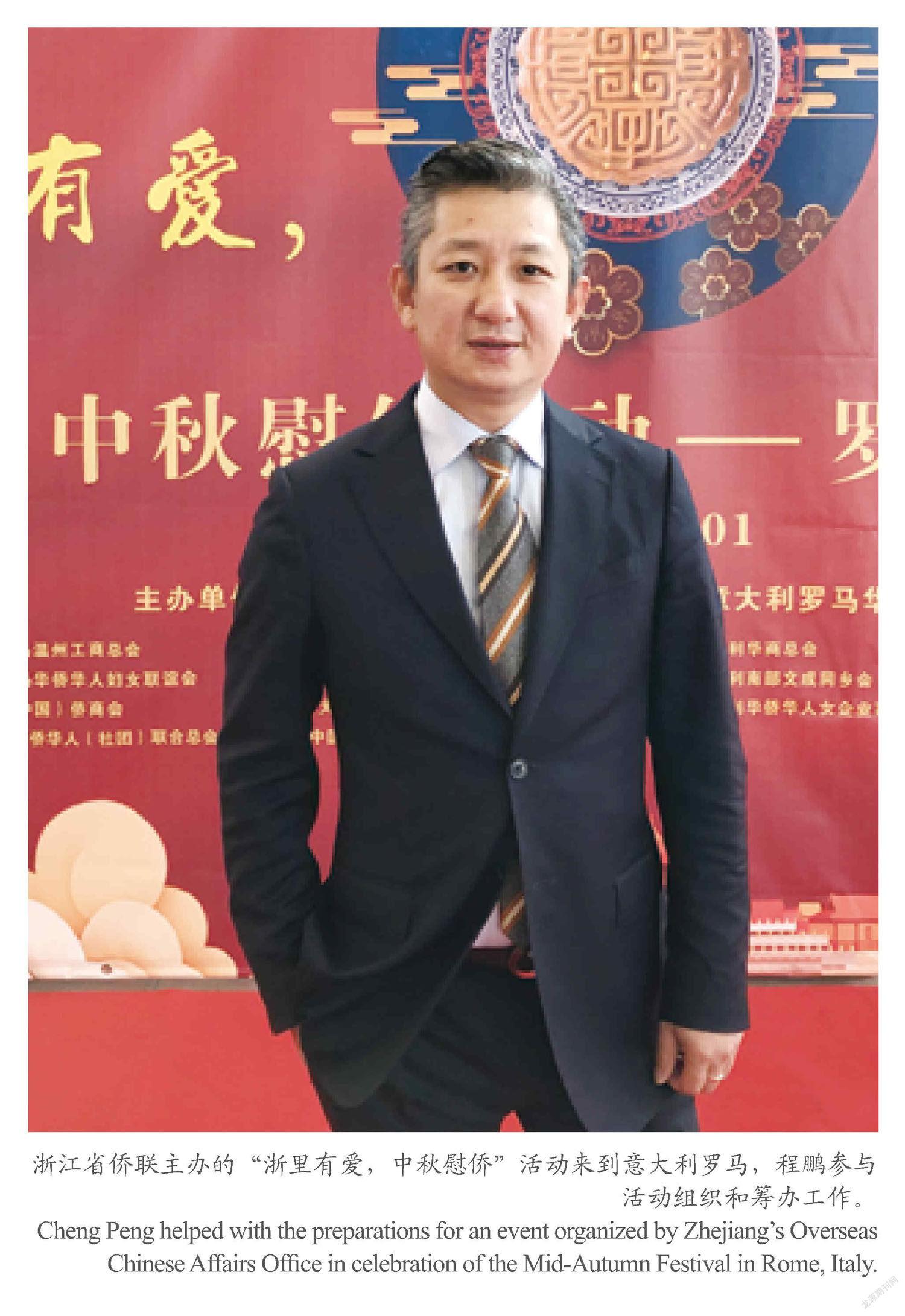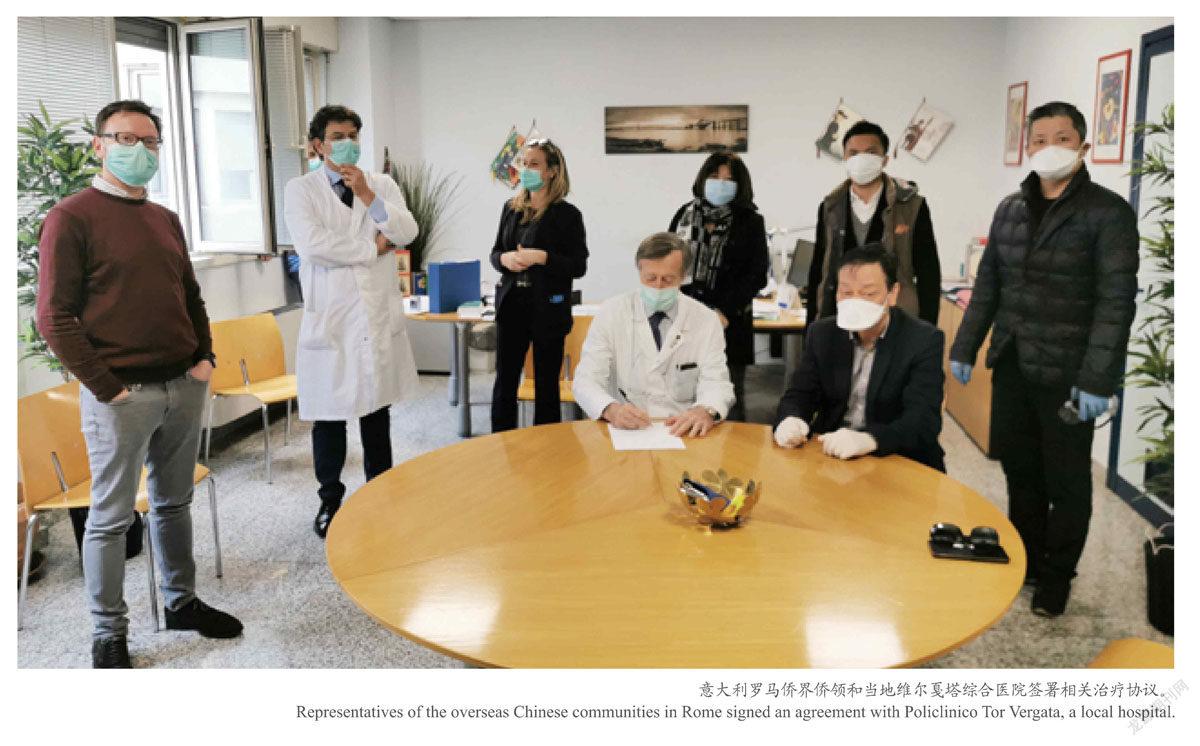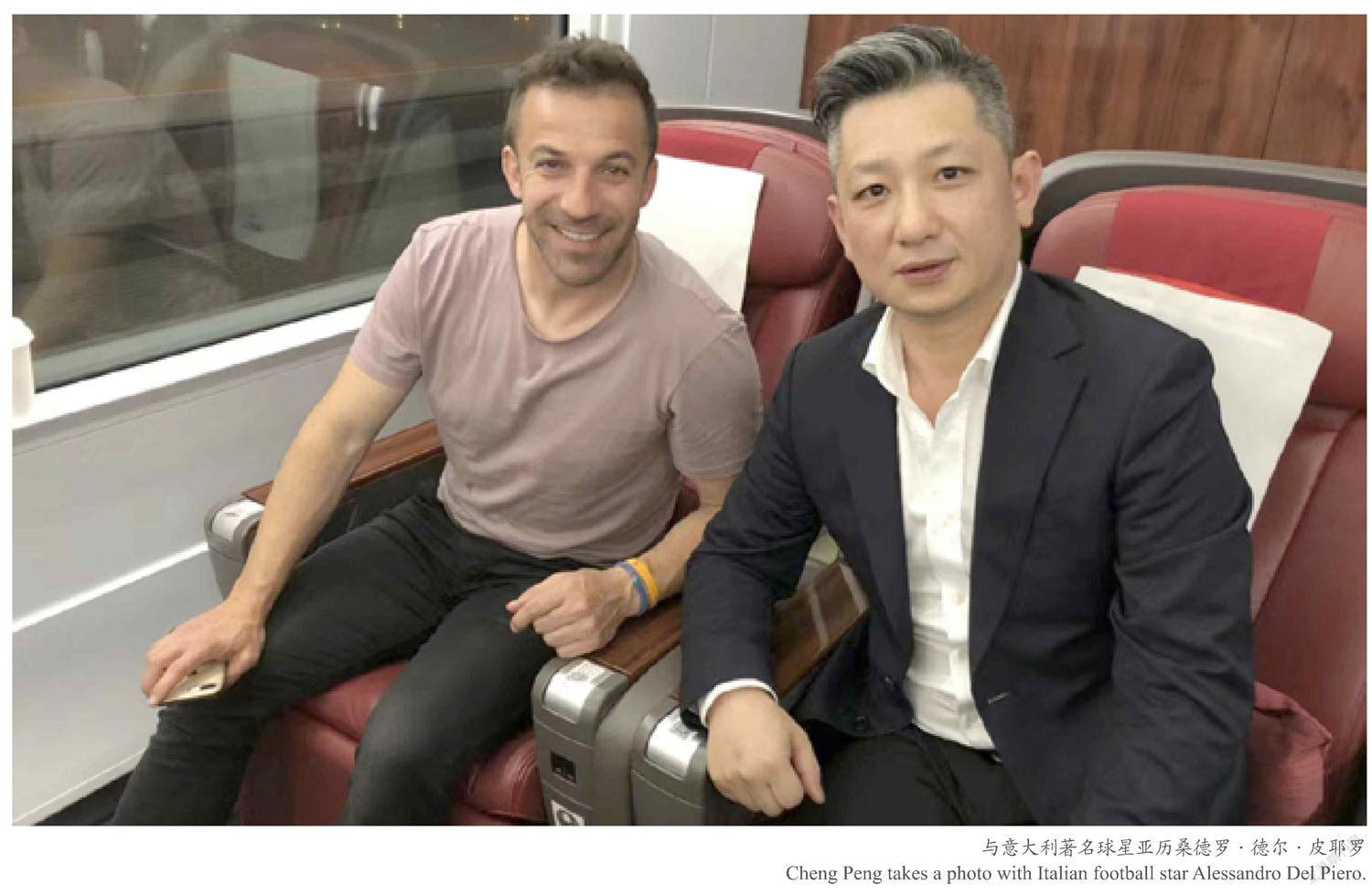程鹏:架起中意美食文化之桥
2022-03-28吴洋
吴洋




经典电影《教父》中有一句来自老教父维托 · 柯里昂的台词,体现了大多数意大利人特别重视家庭陪伴的传统观念。台词是这样说的:“不陪家人的男人,不是好男人。”电影中,有许多镜头记录大家族一起吃饭的场景,这也充分反映出意大利人看重家族感情的维系和人际关系的维护。
在欧洲,很多其他国家和地区的人常常会把意大利称为“欧洲版的中国”,因为意大利和中国在家庭观念、人情关系和美食文化上有许多相似之处。B站上有一位知名up主名叫“善美”,这个来自意大利的姑娘用中文介绍了中意之间的三个共通点:第一,两国都拥有璀璨悠久的古文明历史,中国的汉朝相当于意大利古罗马时期,都是世界文明发展中的重要时代;第二,两国都非常重视家庭关系和人际交往,很多意大利人长大以后会选择和父母继续住一起或住在父母家附近;第三,“民以食为天”的中华饮食文化同样可以用在形容意大利饮食文化,种类丰富、口味独特的中意美食闻名遐迩。
在有如此多共通点的这两个国家中,有一群华人华侨往返于两地、牵系着两者。他们既饱含深情地眷恋着故土亲人,又满怀热情地奔赴异国生活,以中意传统文化、美食文化为纽带,珍惜重视家庭、亲友、邻里、团体组织之间的人情关系,在中意两国之间架起一座座崇尚友好的情感之桥。现任意大利罗马华侨华人联合会执行会长程鹏就是其中一位典型代表。
弘扬中餐文化30载
程鹏是青田人。青田位于浙江西南部,山多田少,自然资源十分有限。但青田人却善于“把一手烂牌打成王炸”,生动诠释了浙江人自古以来的性格基因——互帮互助、踏实肯干、勇于开拓。改革开放后青田迎来出国潮,目的地大多是欧洲,走出去的青田人主要做“三刀一提”:“三刀”指的是厨师、裁缝、理发师;“一提”即提着篮子卖点小玩意儿。亲帮亲、邻带邻,从小买卖做到大生意,不少青田人很快便在欧洲各国站稳了脚跟,并逐渐成为推动当地经济发展的主力军之一。
就是在那样的时代背景下,1992年,年轻的程鹏不远万里来到德国。1995年,恰逢意大利放开对外国人的移民政策,他又辗转迁至罗马。初到意大利的程鹏开始寻找在意大利的谋生之道,餐饮便是他找到的第一条路。没想到的是,这也是沟通意大利文化与中华文化最直接的路径,在这条路上,他一走就走了将近30年。由于具有出众的经商头脑、经营理念、执行能力和实干精神,到意大利后没过几年,程鹏便在罗马国际机场附近和朋友合开了一家中餐馆。当时罗马的华人华侨并不多,中餐馆也很少。程鹏回忆说:“早期我们做的是本地式中餐,菜品单一,制作工序也相对简单,如春卷、虾片、广东炒饭、杏仁鸡丁、麻婆豆腐等。”
20世纪90年代末,欧洲人包括意大利人对中餐文化的了解相对较少,对外来移民者多少抱着“为摆脱贫困而来”的印象。但是,弹指一挥间,几十年过去了,世界格局正在发生深层次变革,中国综合国力日益强盛,中华文化、中华美食文化的影响力也随之扩大到世界各地。这些变化,让从事餐饮行业、每天能接触到形形色色之人的程鹏感受颇深。
“曾经遇到过一些年纪大的客人,对中国的认识似乎还停留在20世纪70年代,殊不知中国早已是全新的面貌。最能深切感受到周围人开始真正了解现代中国的契机,发生在2008年北京举办奥运会。”程鹏谈到,当时他在餐馆里特意添了一台电视机,让顾客们能随时随地观看比赛转播,“很多人看了北京奥运会后会跟我说,你们中国现在真的很棒,和他们想象中的中国完全不一样。近两年更是如此,很多在意大利华人企业上班的来自各个国家或地区的员工多多少少都会讲点中文,社会上更是掀起了学习汉语的热潮”。
聊起中国的发展和中华文化影响力的扩大,程鹏言语间满是激动和自豪。“这种令人欣喜的变化还表现在海外中餐逐渐高端化这一趋势上。我们现在做中餐越做越专业,菜系也越来越丰富多样,从餐馆装潢到菜品摆盘都更加讲究体现中华文化之美。”程鹏介绍说。
美食让交流更活跃
“意大利人和中国人一样,都特别喜爱美食,对吃很讲究。”程鹏介绍说,意大利和中国的相似之处还体现在地理特点上,每个地区都有自身特有的自然产物,物产丰富,从南到北都有不同的美食文化。此外,意大利人非常喜欢吃面食,从上百种意大利面到各种制法的披萨不一而足,甚至还有馄饨、饺子,也是意大利传统家庭菜肴。
作为两大美食之国的沟通使者,程鹏和他的餐馆对中意餐的融合颇有研究。程鹏特别举例提到了对杭州传统名菜——西湖醋鱼的本地化改良。意大利人很喜欢糖醋这一口感,比如对粤菜咕咾肉的喜爱由来已久,但又不擅长吃西湖醋鱼的原材料——草鱼这一类多细刺的淡水鱼,于是他的中餐馆便把鱼种换成了海鲈鱼,既保留了糖醋这一中华传统美食特有的烹制方式,又遵循了包括意大利人在内的欧洲人普遍不吃骨头、不吐刺的饮食习惯,受到了當地人的欢迎和好评。
另一方面,意大利人和中国人同样都非常重视人情交往,而节日是大家聚在一起交流沟通、加深感情的最佳时机。程鹏说,中国传统节日是传承中华优秀传统文化的重要载体,因特定节日诞生、发展而来的民俗活动和美食习惯是中华文化的精髓。因此,每逢中国传统佳节来临之际,程鹏总是会热情地邀请当地政经界要员、文化圈的名人和华人华侨朋友等一起过“中国节”,一起品尝各种具有时令文化特色的中华美食,一起开展如端午赛龙舟、中秋节聆听团圆海潮曲等节庆民俗活动。
此外,在程鹏所属的意大利罗马华侨华人联合总会的支持和帮助下,与孔子学院合作,与以汉语为第一外语的罗马住读理科高中积极开展有关中国文化的活动,更是邀请到中国的乒乓球教练远赴意大利当地,现场教授学生们打乒乓球,进行体育方面的跨国交流与互动。
探索中意文化交流新模式
程鹏透露,2019年,他准备了一箩筐的中意文化交流与合作计划,想要大展抱负。“和意大利政府进行了沟通探讨,研究了各种方案,希望能以意大利各地区和中国各城市的美食文化为纽带,建立城市与城市、地区与地区之间点对点的联系与交流。”程鹏接着说,他当时还准备和浙江商业职业技术学院展开合作,想把浙江菜系的烹制技术作为专业学科引到意大利,并将意大利菜的专业知识带回浙江。
在突如其來的新冠肺炎疫情影响下,一切似乎都被打乱了。然而,程鹏又开始了新的尝试。2020年10月30日,程鹏的第一个系列视频《去哪儿鹏哥》在抖音APP发布,该系列视频的受众主要是因疫情无法前往意大利旅游的中国游客,向他们介绍比较小众却是原汁原味的意大利文化。尽管是第一次录制短视频,他还是组建了一个专业的视频小团队,该团队主要由影视传媒专业的中国留学生组成,引起不少当地华人华侨的兴趣与关注,纷纷向他“取经”。
程鹏表示,今后还将在视频中体现中华文化和意大利文化源远流长的跨国交流历史,同时介绍中国各大城市的历史文化特征和现代发展特色。“只有亲眼看到中国如今的真实样貌,感受到中国的变化,外国人才能真正了解中国。这些视频将用意大利语、英语录制,并发到海外各大视频端口,例如海外版抖音(TIKTOK),让更多海外社交媒体用户可以多渠道、多视点地了解中华文化和中国发展。”程鹏补充说,“除了短视频,还将大力推动中国品牌进入欧洲市场,积极推动两国中小企业间的交流与合作”。
值得一提的是,中国和意大利这两大美食王国还从各自博大精深的古文明中继承了一个共同的思想文化精髓——包容。包容的基础是找到共通点,包容的目的则是实现共享,正是因为清楚地知道这个逻辑和道理,在积极促进中意之间相互交流和理解上,无论是以美食为纽带推进中意交流的程鹏,还是用中文解说意大利文化的B站up主意大利姑娘善美,都在尽心竭力地不断努力,不断发出友好之声,不断点燃两国人民交往中的善意之光。相信万点微光方能汇成海,最终点亮中意两国的朗朗星空。
Cheng Peng:
Building a Bridge between Two Gourmet Countries
By Wu Yang
“A man who doesn’t spend time with his family can never be a real man,” thus admonishes Don Vito Corleone, the Godfather. The line best captures the strong sense of family commonly found in many Italians. In the movie, scenes of a big family having dinner around a large table can be seen everywhere.
Because of the similarity in family values, ways to deal with personal relationships and food culture, Italy is often regarded “China in Europe”. On Bilibili, a Chinese streaming and video-sharing website, Micaela Russo, an Italian lady better known by her Chinese name “Shan Mei” (literally Good Beauty), argued — in flawless Chinese, no less — that there are three commonalities between China and Italy.
First, both have a long and splendid civilization and history. Second, both attach great importance to family and interpersonal relations. Many Italians choose to continue to live with their parents or near their parents when they grow up. Third, the idea that “food is paramount”, which the Chinese people hold dear, is equally applicable to the Italian people.
Like Micaela, a multitude of Chinese have also been traveling between the two nations, building bridges of friendship through the traditional culture and food culture of China and Italy. Cheng Peng, executive chairman of the Overseas Chinese Federation in Rome, is one of them.
Born in Qingtian county, Cheng Peng was among the first waves of local people seeking opportunities abroad. Situated in Wenzhou city, the southwestern part of Zhejiang province, Qingtian is known for its mountainous terrain and scarce natural resources. But nature’s endowment, or lack thereof, has never deterred Qingtian people. With their hardworking attitude, entrepreneurial spirit and pragmatism, they began to travel overseas — mostly to Europe — after the introduction of the reform and opening-up policy. Chefs, tailors and barbers were the most popular jobs they took on, apart from small businesses, which would soon make them a major force driving local economic development.
It was against this backdrop that Cheng reached Germany in 1992, before he went on to Rome, Italy when the immigration policy there relaxed. The first business that Cheng tried was food business, Unbeknownst to him then, food is also the most direct route to connect China and Italy, along which he has treaded in the next three decades.
Several years later, with outstanding business acumen, Cheng was able to open a Chinese restaurant with his friends close to the Fiumicino International Airport. There were not many Chinese in Rome and few Chinese restaurants. “In the early days, we cooked localized Chinese food, including spring rolls, shrimp chips, Mapo tofu, among others,” recalled Cheng.
In the late 1990s, the Italians, and the Europeans for that matter, knew little about Chinese culture and China’s modern development. They held the belief that immigrants came here to “get rid of poverty”.
“I have met some elderly patrons whose knowledge of China is still that of the 1970s, and that is very very outdated,” said Cheng. “I think it was during the 2008 Olympic Games that people around me began to truly understand modern China.” At the time, he set up a new TV in the restaurant for his guests to watch the Games.
“A lot of people told me after watching the Beijing Olympics that China is really great now and it’s totally different from their perceptions,” said Cheng. “In the past few years, employees from different countries or regions working in Italian Chinese companies can speak some Chinese, and learning Chinese is in the vogue.”
China’s rapid development and growing influence can also be seen in the fact that overseas Chinese food is increasingly making inroads into high-end restaurants. “We are becoming more and more professional in preparing Chinese food, and the cuisine is ever more diverse,” said Cheng. “From decorating restaurants to presenting the dishes, diners are now seeing more of the beauty of Chinese culture.”
The Italians, like the Chinese, are fastidious eaters, according to Cheng, and the resemblance between Italy and China is also reflected in geographical features. From the south to the north, each region has its own unique natural resources and rich food culture. Italians are quite into wheaten food as well: from the hundreds of varieties of pasta to pizza, and from wonton to ravioli, they are all traditional Italian food.
As a “messenger” between the two gourmet nations, Cheng has done a lot of work on the fusion of Chinese and Italian food. One case is the adaption of the traditional Hangzhou dish, West Lake Fish in Vinegar Gravy, to local palates. The Italians like the sweet and sour taste —the Sweet and Sour Pork has long been a local favorite. However, they mostly refrain from taking West Lake Fish in Vinegar Gravy, as the fish used for the dish, the grass carp, is too bony. So Cheng replaced it with sea bass, not only retaining the sweet and sour taste, but also agreeable to the habits of European people, including the Italians, who generally prefer filleted fish.
In addition, as a way of bonding with local people, Cheng often invites them to experience traditional Chinese festivals, such as the Dragon Boat Festival and the Mid-Autumn Festival. His federation regularly organizes exchange activities in culture and sports.
“We have held in-depth discussions with the Italian government and studied various plans, hoping to take the food culture of different Italian regions and cities in China as the link and establish point-to-point contact and exchange between them,” Cheng revealed. In fact, he was planning to introduce the cooking techniques of Zhejiang cuisine to Italy as a professional discipline and bring Italian culinary expertise back to Zhejiang.
Unfortunately, all the plans he came up with in 2019 were disrupted by the breakout of COVID-19. Undeterred, Cheng turned his eyes to social media. On October 30, 2020, he released a series of videos titled “Where Are You Going, Brother Peng?” on Douyin, China’s TikTok, introducing Italian culture and attractions to the Chinese audience.
Looking to the future, Cheng planned to produce more short videos that will show the long history of mutual exchanges between Chinese culture and Italian culture, and present the historical and cultural heritage as well as the modern development of major Chinese cities to his Italian audience. “Seeing is believing, and only by seeing with your own eyes what China really looks like today and feeling the changes in China can foreigners truly understand it,” Cheng said. “The videos will be recorded in Italian and English and uploaded to major overseas video-sharing platforms, such as TikTok, so that more overseas social media users can learn about Chinese culture and China's development.”
Besides, Cheng added that more efforts will be spent to vigorously promote the entry of Chinese brands into the European market, and exchanges and cooperation between small and medium-sized enterprises of the two countries.
